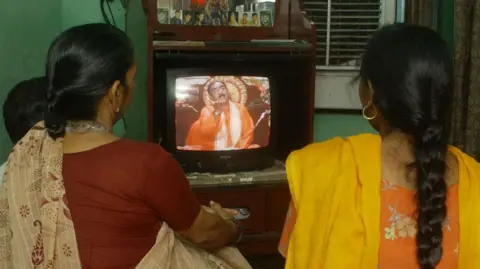“Daya, darwaaza tod do.” (Daya, break down the door)
Most Indians will instantly recognise this dialogue from the popular detective show CID, which ran from 1998 to 2018, making it one of India’s longest-running television shows.
The whodunnit featured three intrepid policemen – ACP Pradyuman, inspector Daya and inspector Abhijeet – solving case after case, as no criminal was ever a match for them. The low-budget episodes had comically simple plots, iffy acting, and all it took for a suspect to confess was a good slap from ACP Pradyuman.
But over the years, the show has achieved cult status, and its characters and dialogues have spawned a wealth of jokes, memes and reels.
CID is set to return later this month, sparking mixed reactions among its fans. Some are eager to see the three policemen back in action but others say that the show’s old-world charm might not fit in with the gritty realism of modern-day crime shows.
Over the past few days, the creators of the show have been releasing teasers for upcoming episodes on Instagram, each garnering hundreds of thousands of likes and comments.
Apart from the three main characters, the teasers feature familiar tropes and dialogues. These include Inspector Daya kicking open doors to reveal a suspect’s hideout and ACP Pradyuman muttering his iconic line, ‘kuch toh gadbad hai, Daya’ (something’s not right, Daya), signaling to both his team and the audience that a crime has taken place.
Trisha Shah, 35, a content creator from Mumbai and a fan of the show, says that the teasers make her nostalgic.
“CID was one of the few crime shows on television back then and my parents didn’t mind me watching it because of its family-friendly content,” Ms Shah says.
“Despite being a crime show, it never showed gruesome violence, sexual crimes, foul language or anything that was not suitable for family viewing.”
In an interview to Film Companion, an entertainment journalism platform, one of the writers of the show said that they even avoided giving surnames to the characters to avoid hurting anyone’s sentiments.
But the show’s outlandish plots more than made up for its primness, whether that was ACP Pradyuman coming back from the dead or inspector Daya single-handedly manoeuvring a poison-gas filled plane to safety.

In an interview to Forbes magazine, the producer of the show, BP Singh, described these scenes and plots as “believable nonsense”.
“You may later laugh at it [the scene]. But for those five minutes, it is so engrossing that you don’t mind it,” he told the magazine.
In a rather comical fashion, the characters would also explain plots and technologies used to solve crimes through their dialogues, making it easy for even children to grasp what was happening.
“The bad guys always got caught and that was comforting to watch,” Ms Shah says. “I don’t think I’ll enjoy the show today, but back then, it was a big deal.”
In the 1990s, TV was a big deal as it was the only form of home entertainment. At the start of the decade, India eased broadcasting rights, making more channels available.
“Initially, channels like Star began showing reruns of American shows like Baywatch and The Bold and The Beautiful. But new entrants like Zee TV and Sony began producing original shows to cater to the Indian audience,” says Harsh Taneja, an associate professor of media at University of Illinois at Urbana-Champaign.
Producers often adapted Western shows for Indian audiences by importing format Bibles – guidelines outlining story structure – and modifying them for local context, he says. So, a show like CID often featured plots that closely resembled those of CSI: Crime Scene Investigation, an American crime drama.
The 1990s and 2000s saw television become a staple in households as people’s spending power grew. Many homes had not just one but two televisions, leading producers to create content targeting different age groups, says Mr Taneja.

Interestingly, the target audience of CID, when it was released in the 1990s, was children in the age group of six to 14. After CID, several other crime-focussed shows began to populate channels – from Crime Patrol to Savadhan India. But one could say that it was CID that created an appetite for crime shows among viewers.
Priya Ravi, 40, remembers waiting eagerly for each CID episode to air when she was a child. She confesses that it was the show that made her push her parents to get a television set at their home.
“Episodes used to air twice a week, and initially I used to go to a friend’s place to watch them. But then I convinced my parents to get a TV so that I could watch the episodes at home. I was so happy the day the TV arrived,” Ms Ravi says.
She says that though she won’t watch the new CID episodes, she’ll definitely encourage her two children, aged seven and nine, to watch them.
“If the show remains as clean as it was back in the day, I think it’s a great way to introduce children to some of the realities of life and make them vigilant about their safety and surroundings,” she says.
“I’m looking forward to the heroic trio making a comeback.”